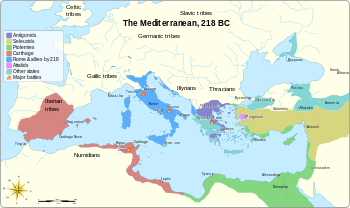Ptolemy IV Philopator
| Ptolemy IV Philopator | |
|---|---|
|
Πτολεμαῖος Φιλοπάτωρ Iwaennetjerwymenkhwy Setepptah Userkare Sekhemankhamun[1] | |
 Gold octadrachm issued by Ptolemy IV Philopator, British Museum | |
| King of Egypt | |
| Reign | 221–204 BC (Ptolemaic) |
| Coregency | Arsinoe III |
| Predecessor | Ptolemy III |
| Successor | Ptolemy V |
| Children | Ptolemy V |
| Father | Ptolemy III |
| Mother | Berenice II |
Ptolemy IV Philopator (Greek: Πτολεμαῖος Φιλοπάτωρ, Ptolemaĩos Philopátōr; reigned 221–204 BC), son of Ptolemy III and Berenice II, was the fourth Pharaoh of Ptolemaic Egypt. The decline of the Ptolemaic dynasty began under the reign of Ptolemy IV.
Family
Among the children of Ptolemy IV Philopator and his sister-wife Arsinoe III of Egypt was Ptolemy V Epiphanes, who married Cleopatra I Syra, daughter of Antiochus III the Great and Laodice III.
Reign
Ptolemy IV's reign was inaugurated by the murder of his mother,[2] and he was always under the dominion of favourites, male and female, who indulged his vices and conducted the government as they pleased. Self-interest led his ministers to make serious preparations to meet the attacks of Antiochus III the Great on Coele-Syria including Judea, and Ptolemy himself was present at the great Egyptian victory of Raphia (217 BC) which secured the northern borders of the kingdom for the remainder of his reign.

The arming of Egyptians in this campaign had a disturbing effect upon the native population of Egypt, leading to the secession of Upper Egypt under pharaohs Harmachis (also known as Hugronaphor) and Ankmachis (also known as Chaonnophris), thus creating a kingdom that occupied much of the country and lasted nearly twenty years.
Philopator was devoted to orgiastic forms of religion and literary dilettantism.[3] He built a temple to Homer and composed a tragedy, to which his favourite Agathocles added a commentary. He married his sister Arsinoë III (about 220 BC), but continued to be ruled by his mistress Agathoclea, sister of Agathocles. In late c. 210 BC, Agathoclea may have given birth to a son from her affair with Ptolemy IV, who may have died shortly after his birth.
Ptolemy is said to have built a giant ship known as the tessarakonteres ("forty"), a huge galley and possibly the largest human-powered vessel ever built. This showpiece galley was described by Callixenus of Rhodes, writing in the 3rd century BC, and quoted by Athenaeus in the 2nd century AD.[4] Plutarch also mentions that Ptolemy Philopator owned this immense vessel in his Life of Demetrios.[5] The current theory is that Ptolemy's ship was an oversized catamaran galley, measuring 128 m 420 ft.
Ptolemy IV is a major antagonist of the apocryphal 3 Maccabees, which describes purported events following the Battle of Raphia, in both Jerusalem and Alexandria.
Legacy
Ptolemy IV's reign was also marked by trade with other contemporaneous polities. In the 1930s, excavations by Mattingly at a fortress close to Port Dunford (the likely Nikon of antiquity) in present-day southern Somalia yielded a number of Ptolemaic coins. Among these pieces were 17 copper mints from the Ptolemy III, Ptolemy IV and Ptolemy V dynasties, as well as late Imperial Rome and Mamluk Sultanate coins.[6]
Ancestry
| Ancestors of Ptolemy IV Philopator | ||||||||||||||||||||||||||||||||||||||||||||||||||||||||||||||||||||||||||||||||||||||||||||||||||||||||||||||||||||||||||||||||||||||||||||||||||||||||||||||||||||||||||||||||||||||||||||||||||||||||||||||||||||||||||||||||||||||||||||||||||||||||||||||||||||||||||||||||||||||||||||||||||||||||||||||||||||||||||||||||||||||||||||||||||||||||||||||||||||||||||||||||||||||||||||||||||||||||||||||||||||||||||||||||||||||||||||||||||||||||||||||||||||||||||||||||||||||||||||||||||||||||||||
|---|---|---|---|---|---|---|---|---|---|---|---|---|---|---|---|---|---|---|---|---|---|---|---|---|---|---|---|---|---|---|---|---|---|---|---|---|---|---|---|---|---|---|---|---|---|---|---|---|---|---|---|---|---|---|---|---|---|---|---|---|---|---|---|---|---|---|---|---|---|---|---|---|---|---|---|---|---|---|---|---|---|---|---|---|---|---|---|---|---|---|---|---|---|---|---|---|---|---|---|---|---|---|---|---|---|---|---|---|---|---|---|---|---|---|---|---|---|---|---|---|---|---|---|---|---|---|---|---|---|---|---|---|---|---|---|---|---|---|---|---|---|---|---|---|---|---|---|---|---|---|---|---|---|---|---|---|---|---|---|---|---|---|---|---|---|---|---|---|---|---|---|---|---|---|---|---|---|---|---|---|---|---|---|---|---|---|---|---|---|---|---|---|---|---|---|---|---|---|---|---|---|---|---|---|---|---|---|---|---|---|---|---|---|---|---|---|---|---|---|---|---|---|---|---|---|---|---|---|---|---|---|---|---|---|---|---|---|---|---|---|---|---|---|---|---|---|---|---|---|---|---|---|---|---|---|---|---|---|---|---|---|---|---|---|---|---|---|---|---|---|---|---|---|---|---|---|---|---|---|---|---|---|---|---|---|---|---|---|---|---|---|---|---|---|---|---|---|---|---|---|---|---|---|---|---|---|---|---|---|---|---|---|---|---|---|---|---|---|---|---|---|---|---|---|---|---|---|---|---|---|---|---|---|---|---|---|---|---|---|---|---|---|---|---|---|---|---|---|---|---|---|---|---|---|---|---|---|---|---|---|---|---|---|---|---|---|---|---|---|---|---|---|---|---|---|---|---|---|---|---|---|---|---|---|---|---|---|---|---|---|---|---|---|---|---|---|---|---|---|---|---|---|---|---|---|---|---|---|---|---|---|---|---|---|---|---|---|---|---|---|---|---|---|---|---|---|---|---|---|---|---|---|---|---|---|---|---|---|---|---|---|---|---|---|---|---|---|---|---|---|---|---|---|---|---|---|---|---|---|---|---|---|---|---|---|---|---|---|---|---|---|---|---|---|---|---|---|---|---|---|---|---|---|---|---|---|---|---|---|---|---|---|
| ||||||||||||||||||||||||||||||||||||||||||||||||||||||||||||||||||||||||||||||||||||||||||||||||||||||||||||||||||||||||||||||||||||||||||||||||||||||||||||||||||||||||||||||||||||||||||||||||||||||||||||||||||||||||||||||||||||||||||||||||||||||||||||||||||||||||||||||||||||||||||||||||||||||||||||||||||||||||||||||||||||||||||||||||||||||||||||||||||||||||||||||||||||||||||||||||||||||||||||||||||||||||||||||||||||||||||||||||||||||||||||||||||||||||||||||||||||||||||||||||||||||||||||
References
- ↑ Clayton (2006) p. 208.
- ↑ Polybius, XV 25.2. Cf. Zenobius, V 94.
- ↑ Bevan, Edwyn (1927). The House of Ptolemy: a History of Egypt under the Ptolemaic Dynasty. London: Methuen. p. 233.
- ↑ Deipnosophistae V 37.
- ↑ Demetrius 43.4-5.
- ↑ Hildegard Temporini (ed.) (1978). Politische Geschichte: (Provinzien und Randvölker: Mesopotamien, Armenien, Iran, Südarabien, Rom und der Ferne Osten)], Part 2, Volume 9. Walter de Gruyter. p. 977. ISBN 3110071754. Retrieved 1 November 2014.
Bibliography
- Clayton, Peter A. (2006). Chronicles of the Pharaohs: the reign-by-reign record of the rulers and dynasties of ancient Egypt. Thames & Hudson. ISBN 0-500-28628-0.
 This article incorporates text from a publication now in the public domain: Chisholm, Hugh, ed. (1911). "article name needed". Encyclopædia Britannica (11th ed.). Cambridge University Press.
This article incorporates text from a publication now in the public domain: Chisholm, Hugh, ed. (1911). "article name needed". Encyclopædia Britannica (11th ed.). Cambridge University Press.
External links
- Ptolemy Philopator I at LacusCurtius — (Chapter VII of E. R. Bevan's House of Ptolemy, 1923)
- Ptolemy IV — (Egyptian Royal Genealogy)
- Ptolemaic Genealogy: Possible child of Ptolemy IV
- The great revolt of the Egyptians:205–186 BC (2004)
- Ptolemy IV Philopator entry in historical sourcebook by Mahlon H. Smith
| Ptolemy IV Philopator Born: Unknown Died: 204 BC | ||
| Preceded by Ptolemy III Euergetes |
Pharaoh of Egypt 221–204 BC |
Succeeded by Ptolemy V Epiphanes |